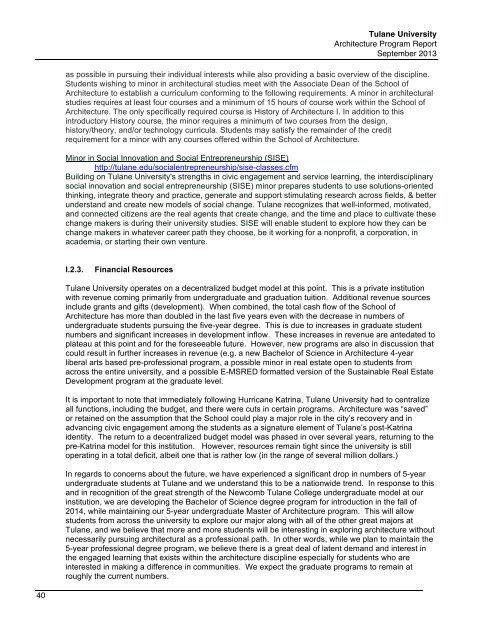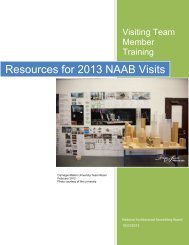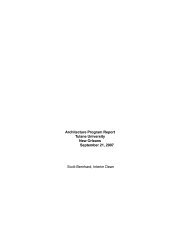NAAB Architecture Program Report (APR) 2013 - Tulane School of ...
NAAB Architecture Program Report (APR) 2013 - Tulane School of ...
NAAB Architecture Program Report (APR) 2013 - Tulane School of ...
You also want an ePaper? Increase the reach of your titles
YUMPU automatically turns print PDFs into web optimized ePapers that Google loves.
<strong>Tulane</strong> University<strong>Architecture</strong> <strong>Program</strong> <strong>Report</strong>September <strong>2013</strong>as possible in pursuing their individual interests while also providing a basic overview <strong>of</strong> the discipline.Students wishing to minor in architectural studies meet with the Associate Dean <strong>of</strong> the <strong>School</strong> <strong>of</strong><strong>Architecture</strong> to establish a curriculum conforming to the following requirements. A minor in architecturalstudies requires at least four courses and a minimum <strong>of</strong> 15 hours <strong>of</strong> course work within the <strong>School</strong> <strong>of</strong><strong>Architecture</strong>. The only specifically required course is History <strong>of</strong> <strong>Architecture</strong> I. In addition to thisintroductory History course, the minor requires a minimum <strong>of</strong> two courses from the design,history/theory, and/or technology curricula. Students may satisfy the remainder <strong>of</strong> the creditrequirement for a minor with any courses <strong>of</strong>fered within the <strong>School</strong> <strong>of</strong> <strong>Architecture</strong>.Minor in Social Innovation and Social Entrepreneurship (SISE)http://tulane.edu/socialentrepreneurship/sise-classes.cfmBuilding on <strong>Tulane</strong> University's strengths in civic engagement and service learning, the interdisciplinarysocial innovation and social entrepreneurship (SISE) minor prepares students to use solutions-orientedthinking, integrate theory and practice, generate and support stimulating research across fields, & betterunderstand and create new models <strong>of</strong> social change. <strong>Tulane</strong> recognizes that well-informed, motivated,and connected citizens are the real agents that create change, and the time and place to cultivate thesechange makers is during their university studies. SISE will enable student to explore how they can bechange makers in whatever career path they choose, be it working for a nonpr<strong>of</strong>it, a corporation, inacademia, or starting their own venture.I.2.3.Financial Resources<strong>Tulane</strong> University operates on a decentralized budget model at this point. This is a private institutionwith revenue coming primarily from undergraduate and graduation tuition. Additional revenue sourcesinclude grants and gifts (development). When combined, the total cash flow <strong>of</strong> the <strong>School</strong> <strong>of</strong><strong>Architecture</strong> has more than doubled in the last five years even with the decrease in numbers <strong>of</strong>undergraduate students pursuing the five-year degree. This is due to increases in graduate studentnumbers and significant increases in development inflow. These increases in revenue are antedated toplateau at this point and for the foreseeable future. However, new programs are also in discussion thatcould result in further increases in revenue (e.g. a new Bachelor <strong>of</strong> Science in <strong>Architecture</strong> 4-yearliberal arts based pre-pr<strong>of</strong>essional program, a possible minor in real estate open to students fromacross the entire university, and a possible E-MSRED formatted version <strong>of</strong> the Sustainable Real EstateDevelopment program at the graduate level.It is important to note that immediately following Hurricane Katrina, <strong>Tulane</strong> University had to centralizeall functions, including the budget, and there were cuts in certain programs. <strong>Architecture</strong> was “saved”or retained on the assumption that the <strong>School</strong> could play a major role in the city’s recovery and inadvancing civic engagement among the students as a signature element <strong>of</strong> <strong>Tulane</strong>’s post-Katrinaidentity. The return to a decentralized budget model was phased in over several years, returning to thepre-Katrina model for this institution. However, resources remain tight since the university is stilloperating in a total deficit, albeit one that is rather low (in the range <strong>of</strong> several million dollars.)In regards to concerns about the future, we have experienced a significant drop in numbers <strong>of</strong> 5-yearundergraduate students at <strong>Tulane</strong> and we understand this to be a nationwide trend. In response to thisand in recognition <strong>of</strong> the great strength <strong>of</strong> the Newcomb <strong>Tulane</strong> College undergraduate model at ourinstitution, we are developing the Bachelor <strong>of</strong> Science degree program for introduction in the fall <strong>of</strong>2014, while maintaining our 5-year undergraduate Master <strong>of</strong> <strong>Architecture</strong> program. This will allowstudents from across the university to explore our major along with all <strong>of</strong> the other great majors at<strong>Tulane</strong>, and we believe that more and more students will be interesting in exploring architecture withoutnecessarily pursuing architectural as a pr<strong>of</strong>essional path. In other words, while we plan to maintain the5-year pr<strong>of</strong>essional degree program, we believe there is a great deal <strong>of</strong> latent demand and interest inthe engaged learning that exists within the architecture discipline especially for students who areinterested in making a difference in communities. We expect the graduate programs to remain atroughly the current numbers.40














